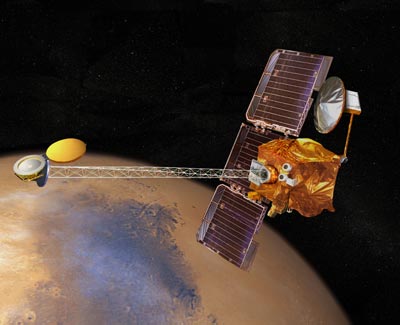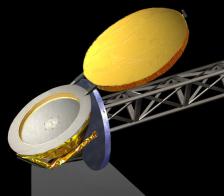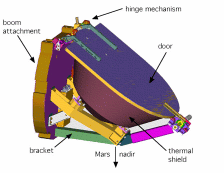






Odyssey, March 2002. Editor: Kris Cerone
In Search of Ancient Shores
By Robert Gounley
Joseph Campbell, in his many books on mythology, writes about the heroes of many cultures and of many times. These tales, told by the old for the instruction of the young, often have the hero confronted by a challenge requiring him to journey far beyond his home and everything he knew. Crowds sat spellbound around their campfire, hearing how their hero overcame great obstacles, beheld great wonders, conquered his enemy, and returned to tell the story.
 |
| Artists conception of spacecraft 2001 Mars Odyssey around Mars. NASA/JPL/Caltech Click to enlarge. |
In the end, the dragon lays slain or the princess captured or one of a hundred variations. In the hands of a good storyteller, the conclusion is never quite what it seemed it would be at the beginning. The hero's quest has imparted valuable lessons that transcend the goals that once seemed so simple. The journey has changed the traveler. Coming home, he sees his own world in new and revealing ways.
To the ancient Greeks, their greatest storyteller was Homer and his greatest tale was the Odyssey. It tells the aftermath of battle waged at the far reaches of the world then known. Odysseus , the victorious hero returns a changed man, having survived giants, whirlpools, and other calamities far more dangerous than the Trojans he had just defeated. The spoils of war have become trivial compared to the wonders found on unfamiliar shores of the Eastern Mediterranean. Little wonder the story's name came to mean any great transforming journey, like the one Arthur C. Clarke created in his screenplay for 2001: A Space Odyssey.
Now we have a spacecraft named "Mars Odyssey" has begun a two-year mission to map the Martian surface. According to the project's Webster, "The name '2001 Mars Odyssey' was selected as a tribute to the vision and spirit of space exploration as embodied in the works of renowned science fiction author Arthur C. Clarke. Evocative of one of his most celebrated works, the name speaks to our hopes for the future and of the fundamental human desire to explore the unknown despite great dangers, the risk of failure and the daunting, enormous depths of space."
It is good to credit a fine contemporary author, but the justification given feels incomplete. Reaching out against great odds is a good sentiment, but it doesn't convey the sense of wonder Homer and Clarke described. Imagine our ancient storyteller gathering the villagers around the communal fire to say our hero "slew a dragon and stuff".
A "Mars Odyssey" calls for a transforming experience. There may be one that even Homer could appreciate - charting a lost ocean.
 |
| Gamma sensor head. NASA/University of Arizona |
Atmospheric measurements show that Mars is an arid world. The air is so thin that what little ice is apparent at the poles turns directly to vapor when heated. However, pictures taken by previous spacecraft show signs that the surface once had free-flowing water. The Northern Hemisphere contains a great basin whose contours resemble ocean shores. Long, meandering channels, resembling dry riverbeds, lead to it. The best explanation is that Mars once had a much denser atmosphere that supported liquid water, but Mars's weak gravity allowed the Sun to drive most of it into space, taking the water with it.
Today, water ice is visible at the Martian poles, but how much water ice remains in the soil is still unclear. To know how much water Mars once had, we should first discover how much water Mars has now. One of Odyssey's scientific instruments is doing just that.
The high-tech divining rod is called a Gamma-Ray Spectrometer (GRS). It measures high-energy radiation emitted when a radioactive atom decays. Each gamma ray has a distinctive signature indicating the chemical element it came from. By counting and identifying this radiation, Odyssey's GRS can sense when it flying over a rich deposit of iron or aluminum or many other elements. Without even touching the ground, Odyssey will tell us where we're likely to find particular minerals when future astronauts go rock hunting.
One feature of the GRS detectors is their ability to measure the radiation signature produced when cosmic rays collide with hydrogen, even when it is one meter or more below the surface. On Mars, a strong hydrogen signature almost certainly points to water in the form of ice or trapped in the local minerals. At a press conference on the second of March, scientists announced that the detector was working so well that they already have an early map roughly suggesting where water is most abundant.
 |
| Drawing of Gamma Sensor Head components. NASA/University of Arizona |
The reason for their surprise is that the GRS has not yet been allowed to operate at its greatest sensitivity. The spacecraft, like surface of Mars, emits some radiation from the metals it is made from. This background noise limits how well it can measure emanations from the Martian soil. In a few months, a deployable boom will extend GRS away from the body of the spacecraft, improving its performance greatly. Maps of minerals, including trapped water, may become as detailed as maps of the Earth.
Today's Odyssey may tell us of oceans long gone before men and women first crossed the Mediterranean Sea. How large were they? Have they completely vanished or are there still pockets in the form of ice near the surface? Could they have lasted long enough to nurture primitive life? The journey Mars Odyssey is taking may well change our perceptions of Mars and make Earth seem a little less unique.
Someday, astronauts will walk along a Martian shoreline. Will they gaze at the horizon and imagine sails silhouetted against the Martian sky?
For more information about Mars Odyssey and its mission, see 2001 Mars Odyssey Homepage, 2001 Mars Odyssey Gamma Ray Spectrometer, Russian High Energy Neutron Detector, 2001 Odyssey THEMIS, MARIE - 2001 Odyssey.
Copyright © 1998-2003 Organization for the Advancement of Space Industrialization and Settlement. All Rights Reserved.